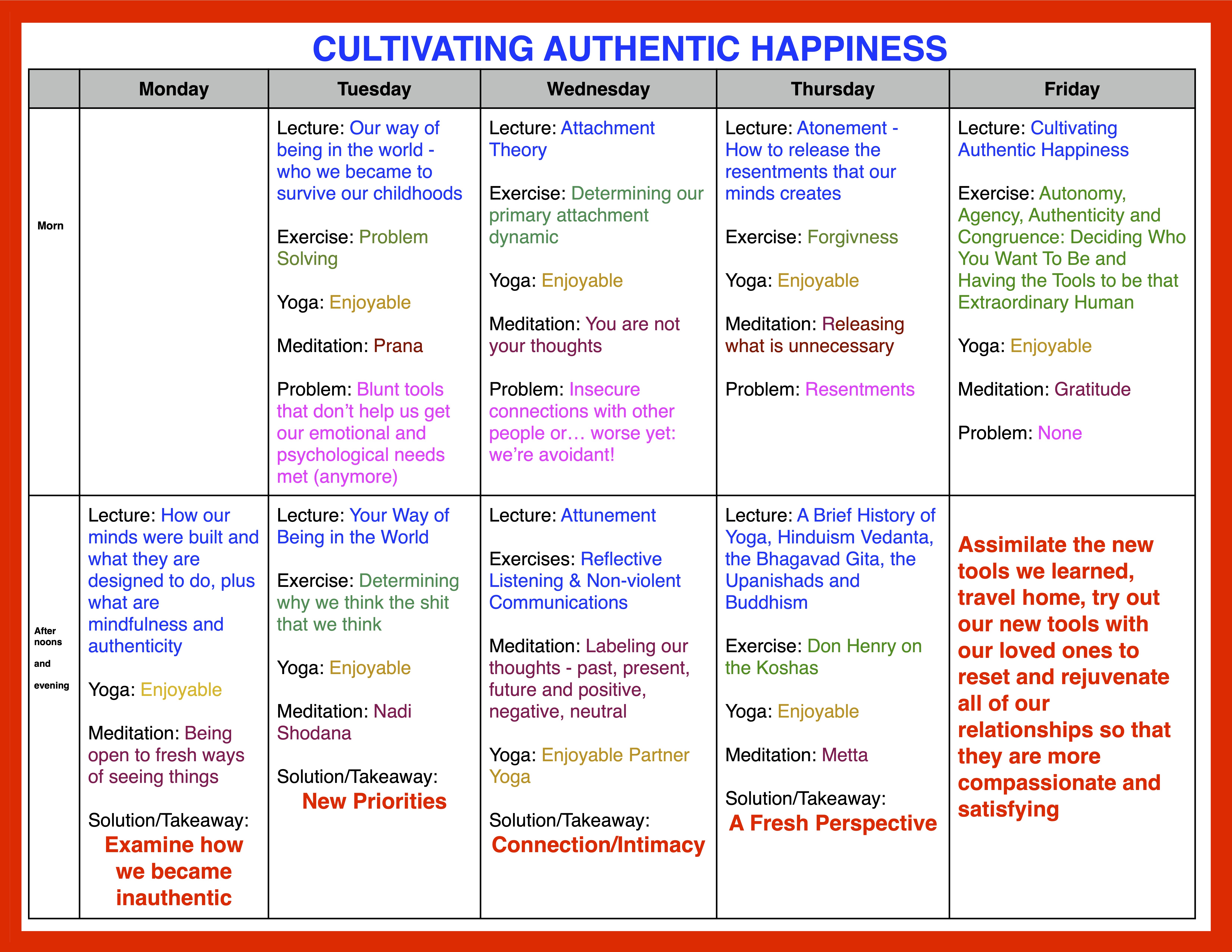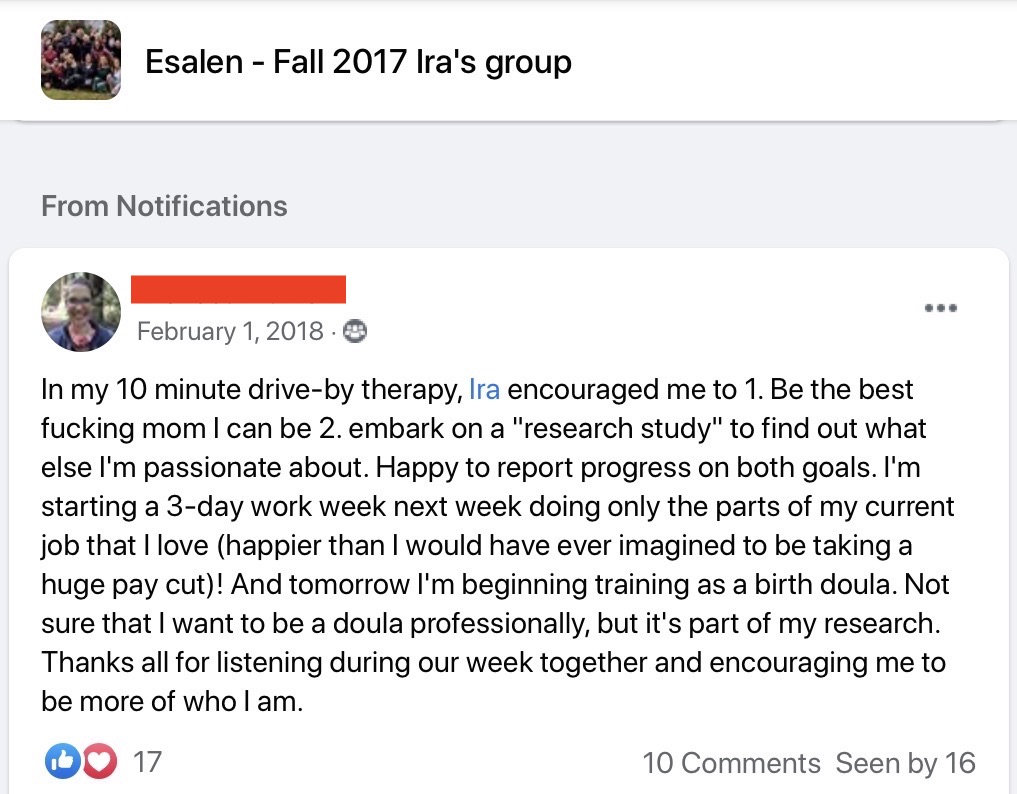I have had the eminent privilege to teach at the Esalen Institute for nine years and am now mentoring young teachers who wish to be effective workshop leaders. This is what I relay to them:
1. Know the lineage of where you are teaching (i.e. read Jeffrey Kripal’s historical paean “Esalen: The Religion of No Religions”). Founded in 1962 by Stanford graduates Michael Murphy and Dick Price, the Esalen Institute was created to allow intellectuals the freedom to explore non-traditional (primarily non-Western) ideas, ideologies, and practices. Many of the notable teachers were psychologists who had studied at Harvard and Stanford (Price did graduate work at Harvard and Murphy at Stanford) but felt that the Western paradigm was limited. Alan Watts gave the first lecture at Esalen and was amongst an array of resident scholars that included sundry intellectual heroes such as Gregory Bateson, Joseph Campbell, Stanislav Grof, Sam Keen, George Leonard, Fritz Perls, Ida Rolf, Virginia Satir, Abraham Maslow, Carl Rogers, B.F. Skinner, and Arnold Toynbee. Buckminster Fuller, Timothy Leary, and Ram Dass (and infamously Hunter Thompson) also spent time at Esalen, hanging out, partaking in and leading experiential workshops and encounter groups. If you are going to teach at such a unique and prestigious institution, you should know the lineage of all of the psychological teachings that emanated from the institution. “We are standing on the shoulders of giants,” is how I open all of workshops and recount a brief history of the hallowed grounds on which we are walking. In addition, many amazing musicians played and hung out at Esalen such as Joan Baez, Bob Dylan, George Harrison, Joni Mitchell, and Crosby, Stills, Nash & Young. In order to progress and transform our deeply unhealthy society, we need to be cognizant of and respect its history – both the good and bad.

2. Over-prepare. Aside from my 3 graduate degrees I also attended a graduate program in filmmaking where I learned the adage “95% of production is pre-production.” Thus, for my 22 hours of lectures and yoga and meditation instructions I come with 26 hours of material and have multiple computers, projectors, cables, etc. so that any catastrophic event that would waylay most performances wouldn’t even be a bump in the road to me. I tell my four assistants, “Imagine that we are putting on a performance of ‘Hamilton’ for four days in Big Sur and that all of the audience members have travelled hundreds if not thousands of miles to see our show. We cannot afford for anything to go awry.” Over-prepare. Expect the unexpected.

3. Over-deliver. Between the fun and exhilerating formal morning and afternoon classes, I conduct “Drive Through Therapy” or “Drive Through Coaching” sessions wherein each student has ten minutes to apply the tools from my classes, my book and online courses to solve or resolve a problem in his or her life. These sessions are hugely intense and intimate with most people bringing me problems that they have worked on for years or even decades in therapy. As a licensed psychotherapist, my job is to show these people what is in their blindspots; give them fresh perspectives so that they can approach past traumas in a completely new manner. And if you look at various postings on social media and my Google business listing you will find that my batting average isn’t terrible.

4. Host inclusive dinner parties and make sure that everyone feels connected to at least a few other people in the group. I begin with an ice-breaking exercise called “Pimp Your New Friend” that I learned at a Harvard-Stanford event wherein everyone introduces someone they just met to the rest of the group. Throughout the formal classes there are awesome connections made in dyads and triads and groups, but breaking bread with fellow humans is where the real magic happens. As I wrote in my book: “Mirror neurons do not fire via text message.” What is severely lacking in our culture is obvious: long languid meals at one table for 60 people where everyone feels as if they are an essential part of the conversation. To me, this is where the real healing takes place.

5. Produce talent shows that allow hundreds of strangers to live their dreams by singing and dancing together.
6. Invite all of the Esalen staff members and employees to join all of your classes and events. These people work hard and are often excessively grateful to be included in our classes, dinners and events.
7. Meet all of your students where they are at. I think that most yoga and meditation teachers are subpar because they inflict specific practices on students rather them offer them a smorgasbord of opportunities to choose from. My classes offer 4 or 5 completely different types of yoga and 6-7 completely different types of meditation. There is no “one-size-fits-all” in spirituality and any yoga or meditation teacher who has created a “brand” (usually these ignoramuses refer to themselves as “Public Figures” on Instagram) doesn’t really understand how to empower people nor what Esalen is really about.
8. Additionally, yoga and meditation are tools with varied lineages. They are means. They are not ends. I teach students “how” to practice different types of yoga and “how” to practice different types of meditation. These are INDIVIDUAL practices. After my instructions the students can go practice on their own. It is pointless to do 6-7 hours of meditation or yoga in a group. Yoga and meditation are the dessert, not the main course. If students want a yoga vacation with a yogalebrity then they should go to Costa Rica or Bali, not Esalen. Esalen is the last psychologically and spiritually oriented intellectual bastion for transforming individuals and our society. It’s not a place for better abs.
9. Model Authenticity. I teach that the only thing that correlates with happiness is the quality of our intimate relationships; our intimate relationships depend on our ability to unlearn all of the prejudices that now constitute our personalities and be authentic. After studying Wittgenstein, Lacan and Foucault for many years, I tell all of my students that “I don’t think you can teach anyone past the age of ten years old anything. But you can inspire them. You can inspire them to want to go outside of their comfort zones and try new solutions.” I model authenticity and I share my personal journey from near-fatal car accident to studying philosophy, psychology and spirituality and trying every self-help modality known to god and human. Again, don’t believe me when I tell you that my 22 hour show of magic, music, illusions, mentalisms, yoga, meditation, Buddhism, Hinduism, philosophy and literary quotes is transformational: believe the testimonials of my students.
10. Tools. Provide every student with an array of new tools that they can apply to their lives when they leave Esalen. Here are some of the tools that my students leave my workshop with:
- The three-part breath to take you out of fight/flight mode
- “Clap last Thursday” – You can’t change the past so what good does it do complaining about it?
- Fred Luskin problem solving exercise to prove that our thoughts, feelings and actions are maladaptive
- Know your core wound and how to react when the wounded child in you is triggered
- Know how you self-sabotage and how to auto-correct
- Metta Meditation to create a microcosm of safety, health and well-being
- How to create an anchor for clarity of consciousness, communications and sentiments
- How to replace the resentments that your mind creates with gratitude
- Reflective listening to be able to attune to others and make them feel heard
- Non-violent communications in order to reduce blame
- “How do we make this a win-win situation?”
- Love languages: Quality time, Words of affirmation, Gifts, Acts of service, Physical touch
- “What can we do to facilitate each other’s greatness?”
- Cleaning up the past in order to show up authentically for the present moment
- Forgiveness and self-forgiveness
- Accident Victims and Lottery Winners study
- Agency: be more pro-active
- Observing thoughts meditation: You are not your thoughts
- “Doctor it hurts when I go like this…” (You already know the answer)
- Alternate nostril breath to balance masculine/feminine energies
- Beginner’s Mind – seeing old problems from fresh perspectives
- Congruence – deciding the life you want to create
- What do you want it to read on your tombstone?
In summary, I have been privileged to have many wonderful Esalen faculty members act as mentors for me: Larry Payne, Ron Alexander, Katherine Woodward Thomas, Linda Bloom, Lorin Roche, and Warren Farrell just to name a few. I have also greatly appreciated the time I have spent at Esalen with legends such as Sam Keen, Michael Murphy, Chip Conley, Paula Shaw, Ann Bradney and Reverend Michael Beckwith.
I did over 25 years of academic work before I started to teach. In a society where pedagogy has become performance and a generation of influencers hawk their wares as phony, self-proclaimed “Public Figures” and “Best-Selling Authors“, gravitas remains imperative to demonstrating that there are new possibilities for a more compassionate, authentic and loving society.


